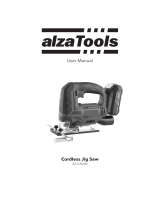
PTS 20-Li A1
GB
│
CY
│
9 ■
Safety instructions for abrasive saws
a) The blade guard, which is a part of the power
tool, must be attached securely and set in a
way that ensures maximum safety, i.e. the
smallest possible amount of the grinding tool
is exposed to the operator. Ensure that you
and anyone else in the vicinity remain outside
of the range of the rotating grinding disc. The
blade guard is designed to protect the operator
from fragments and accidental contact with the
grinding tool.
b) Use only diamond-coated cutting discs for
your power tool. Just because you can attach
the accessories to your power tool, does not
ensure they are safe to use.
c) The permissible speed of the accessory tool
used must be at least as high as the maximum
speed specified for the power tool. Accesso-
ries which rotate faster than the maximum per-
missible rate can break and throw pieces into
the air.
d) Grinding tools should only be used for the
recommended applications.
For example: never grind with the side sur-
face of a cutting disc. Cutting discs are de-
signed to remove material with the edge of the
disc. Any lateral application of force on these
grinding tools can lead to a breakage.
e) Always use an undamaged clamping flange
of the correct size and shape for the selected
grinding disc. Suitable flanges support the
grinding disc and reduce the risk of a disc
breakage.
f) Do not use worn grinding discs from larger
power tools. Grinding discs for larger power
tools are not designed for the higher rotational
speeds of smaller power tools and can break.
g) The external diameter and thickness of the
accessory tool used must comply with the
dimensions of your power tool. Incorrectly
dimensioned accessory tools cannot be suffi-
ciently shielded or controlled.
h) Grinding discs and flanges must fit precisely
onto the grinding spindle of your power tool.
Accessory tools which do not fit precisely on the
grinding spindle of the power tool will rotate
unevenly, vibrate severely and can lead to a
loss of control.
i) Do not use damaged grinding discs. Check
the grinding discs before each use for chips
and cracks. If the power tool or grinding disc
is dropped, check to see if either is damaged,
or use an undamaged grinding disc. After
checking and inserting the grinding disc,
ensure that you and any other people in the
vicinity remain outside of the range of the
rotating grinding disc and allow the tool to
rotate at maximum speed for one minute.
Damaged grinding discs usually break during
this test period.
j) Wear personal protective equipment.
Depending on the application, ensure that
you use full face protection, eye protection
or goggles. If required, use a dust mask, ear
muffs, protective gloves or a special apron
to protect you from grindings and material
particles. Protect your eyes from flying debris
that may be created during certain applica-
tions. Dust or filter masks must be used to filter
any dust produced by the application. If you
are exposed to loud noise for any length of
time, you can suffer a hearing loss.
k) Ensure that other people remain at a safe
distance to your workspace. Anyone who
enters the workspace must wear personal
protective equipment. Fragments of the work-
piece or broken accessory tools can fly off and
cause injury – even outside the immediate work-
ing area.
l) Hold the appliance only by the insulated
handles if you are carrying out any work
during which the attached tool could contact
hidden power cables. Contact with a live cable
can also make metal parts of the appliance live
and could result in an electric shock.
IB_308610_PTS20-LiA1_LB7.indb 9 12.03.2020 13:32:31




















